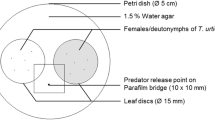Abstract
The effect of leaf hairs on searching efficiency of adult female Phytoseiulus persimilis was investigated. For this purpose we used the ornamental crop Gerbera jamesonii and determined the predator's searching efficiency on three cultivars that differ largely in the density of leaf hairs on the undersurface of the leaves. Walking speed of the mites was highest on the cultivar with the lowest leaf hair density. Walking activity, defined as the percentage of time spent walking, was not dependent on leaf hair density of the cultivars. At both prey densities tested, time until first predation increased with leaf hair density. The predation rate of adult female P. persimilis is affected by trichome density, particularly when prey density is low. At prey densities of 1.3 and 2.5 Tetranychus urticae eggs cm–2, predation rate was inversely related to leaf hair density. At a prey density of 8.0 eggs cm–2 no significant effect of leaf hair density on predation rate was found. These negative effects on searching efficiency and predation success at low prey density of P. persimilis suggest that biological control of T. urticae on gerbera may be hampered by leaf hairs. © Rapid Science Ltd. 1998
Similar content being viewed by others
REFERENCES
Bakker, F.M. and Klein, M.E. 1992. Transtrophic interactions in cassava. Exp. Appl. Acarol. 14: 293-311.
Barret, D. 1994. Influence de l'architecture du phylloplan dans l'organisation des peuplements de Phytoseiides (Acari) et dans leurs associations avec les plantes. PhD thesis, ENSA, University of Montpellier.
Bergman, J.M. and Tingey, W.M. 1979. Aspects of interaction between plant genotypes and biological control. Bull. Entomol. Soc. Amer. 25: 275-279.
de Ponti, O.M.B., van Lenteren, J.C. and Sabelis, M.W. 1988. Halfhaired cucumbers and trichomeless tomatoes for improved biological control of the glasshouse whitefly and the twospotted spider mite. Bull IOBC/WPRS 11(3): 22-23.
Dicke, M. 1996. Plant characteristics influence biological control agents: implications for breeding for host plant resistance. Bull. IOBC/WPRS 19(5): 72-80.
Dicke, M. 1998. Direct and indirect effects of plants on beneficial organisms. In Handbook of pest management, J.R. Ruberson (ed.), pp. 105-153. Marcel Dekker, Inc, New York.
Downing, R.S. and Moillet, T.K. 1967. Relative densities of predacious and phytophagous mites on three varieties of apple trees. Can. Entomol. 99: 738-741.
Duso, C. 1992. Role of Amblyseius aberrans (Oud.), Typhlodromus pyri Scheuten and Amblyseius andersoni (Chant) (Acari, Phytoseiidae) in vineyards. J. Appl. Entomol. 114: 455-462.
Grevstad, F.S. and Klepetka, B.W. 1992. The influence of plant architecture on the foraging efficiencies of a suite of ladybird beetles feeding on aphids. Oecologia 92(3): 399-404.
Heinz, K.M. and Parrella, M.P. 1994. Poinsettia (Euphorbia pulcherrima Willd. ex Koltz.) cultivar-mediated differences in performance of five natural enemies of Bemisia argentifolii Bellows and Perring, n. sp. (Homoptera: Aleyrodidae). Biol. Control 4: 305-318.
Hulspas-Jordaan, P.M. and van Lenteren, J.C. 1978. The relationship between host-plant leaf structure and parasitization efficiency of the parasitic wasp Encarsia formosa Gahan (Hymenoptera: Aphelinidae). Med. Fac. Landbouww. Rijksuniv. Gent 43: 431-440.
Karban, R., English-Loeb, G., Walker, M.A. and Thaler, J. 1995. Abundance of phytoseiid mites on Vitis species: effects of leaf hairs, domatia, prey abundance and plant phylogeny. Exp. Appl. Acarol. 19: 189-197.
Keller, M.A. 1987. Influence of leaf surfaces on movements by the hymenopterous parasitoid Trichogramma exiguum. Entomol. Exp. Appl. 43: 55-59.
Overmeer, W.P.J. and van Zon, A.Q. 1984. The preference of Amblyseius potentillae (Garman) (Acarina, Phytoseiidae) for certain plant substrates. In Proceedings of the VIth International Congress of Acarology, D.A. Griffiths and C.E. Bowman (eds) pp. 591-596. Ellis Horwood, Chicester Edinburgh.
Rabbinge, R. 1976. Biological Control of the Fruit Tree Red Spider Mite. Simulation Monographs. Pudoc, Wageningen.
Sabelis, M.W. 1981. Biological control of two-spotted spider mites using phytoseiid predators. Part I: modelling the predator-prey interaction at the individual level. PhD thesis, Pudoc, Wageningen.
Sabelis, M.W. and Dicke, M. 1985. Long range dispersal and searching behaviour. In Spider mites, their biology, natural enemies and control, Vol. 1B, W. Helle and M.W. Sabelis (eds), pp. 141-160. Elsevier, Amsterdam.
Siegel, S. and Castellan, N.J. 1988. Nonparametric Statistics for the Behavioral Sciences. McGraw-Hill International Editions, New York.
Sütterlin, S. and van Lenteren, J.C. 1997. Influence of hairiness of Gerbera jamesonii leaves on the searching efficiency of the parasitoid Encarsia formosa. Biol. Control 9: 157-165.
van Haren, R.J.F., Steenhuis, M.M., Sabelis, M.W. and de Ponti, O.M.B. 1987. Tomato stem trichomes and dispersal success of Phytoseiulus persimilis relative to its prey Tetranychus urticae. Exp. Appl. Acarol. 3: 115-121.
van Lenteren, J.C. and de Ponti, O.M.B. 1990. Plant-leaf morphology, host-plant resistance and biological control. Symp. Biol. Hung. 39: 365-386.
van Lenteren, J.C., Hulspas-Jordaan, P.M., Li Z.H. and de Ponti, O.M.B. 1987. Leaf hairs, Encarsia formosa and biological control of whitefly on cucumber. Bull. IOBC/WPRS 10(2): 92-96.
van Lenteren, J.C., Li Z.H., Kamerman, J.W. and Xu R., 1995. The parasite-host relationship between Encarsia formosa (Hym., Aphelinidae) and Trialeurodes vaporariorum (Hom., Aleyrodidae). XXVI. Leaf hairs reduce the capacity of Encarsia to control greenhouse whitefly on cucumber. J. Appl. Entomol. 119: 553-559.
Walter, D.E. 1992. Leaf surface structure and the distribution of Phytoseius mites (Acarina: Phytoseiidae) in south-east Australian forests. Aust. J. Zool. 40: 593-603.
Walter, D.E. 1996. Living on leaves: mites, tomenta, and leaf domatia. Annu. Rev. Entomol. 41: 101-114.
Author information
Authors and Affiliations
Rights and permissions
About this article
Cite this article
Krips, O., Kleijn, P., Willems, P. et al. Leaf hairs influence searching efficiency and predation rate of the predatory mite Phytoseiulus persimilis (Acari: Phytoseiidae). Exp Appl Acarol 23, 119–131 (1999). https://doi.org/10.1023/A:1006098410165
Issue Date:
DOI: https://doi.org/10.1023/A:1006098410165




